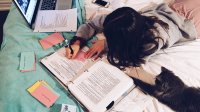Teaching Young Students How to Use Multiple Sources
Two literacy experts offer strategies for helping elementary and middle school students understand how to use and synthesize different sources for research.
Your content has been saved!
Go to My Saved Content.For young students who haven’t conducted research before, deciphering and synthesizing multiple sources—and making connections between them—can be tricky, write literacy experts Martha Polley and Sunday Cummins, who share an approach for boosting these skills in the classroom in “Students Making Sense of Multiple Sources” for MiddleWeb.
First, Polley and Cummins say sources need to be organized in a way that helps students access different types of material at varying levels of complexity. In a history class, this could mean giving students a primary document, a video to watch, and a historian’s account of a particular time period. “While we want students to eventually locate sources on their own, beginning with a set of sources that have already been vetted and organized by the teacher can serve as a mentor for the types of sources students should eventually seek out for themselves,” they write.
Determining an anchor source, like a novel about the topic being studied, can also provide a helpful foundation for teachers to model appropriate strategies and approaches for students. Teachers can read aloud to the entire class from the anchor text, for example, to probe students’ thinking and help “demonstrate strategies like how to identify a main idea and supporting details, how to notice the perspective of an author or narrator, and how to examine the structure of a source, as well as how to do each of these things across sources,” Cummins and Polley write.
Additionally, students new to research often need support in identifying clear purposes for their research, as they often have a hard time identifying patterns and discerning between essential and non-essential sources. Teachers can guide students through their initial vetting of sources by encouraging questions such as, “Is this new information? Or did I read about this in another source?” As they read, students should look for similarities and differences in the texts. While synthesizing information, students are then able to identify subtopics that guide their research moving forward, Polley and Cummins say.
To deepen student learning and understanding, try to integrate texts from multiple sources during class activities to show students different perspectives that challenge their thinking, the experts recommend. One teacher who worked with Polley asked students to sort the text from multiple sources into groups by theme, explaining their thought process as they went along, for example. This experience helped students distinguish the main idea from supporting details while boosting their reading comprehension and research skills.
